#Stratovolcano Fuego
Explore tagged Tumblr posts
Text
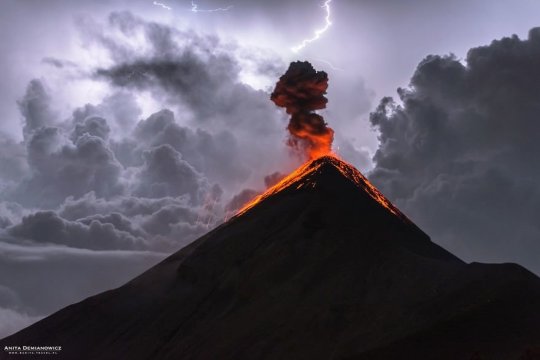


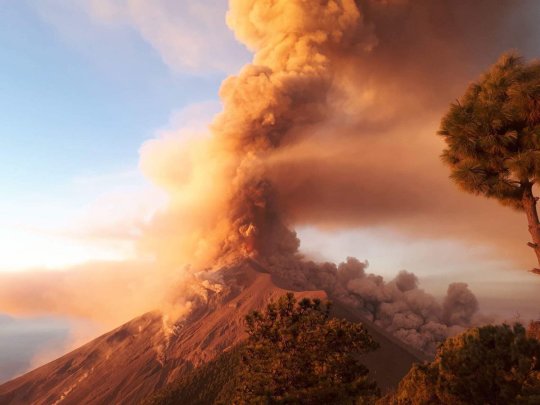



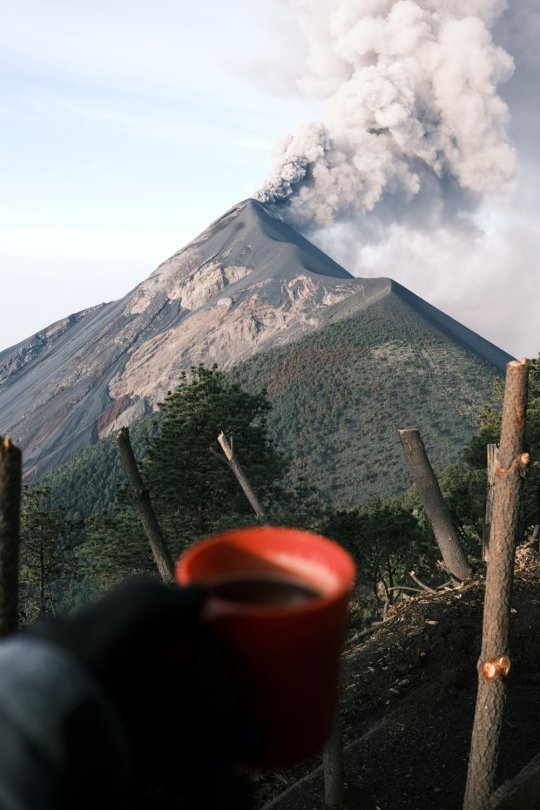

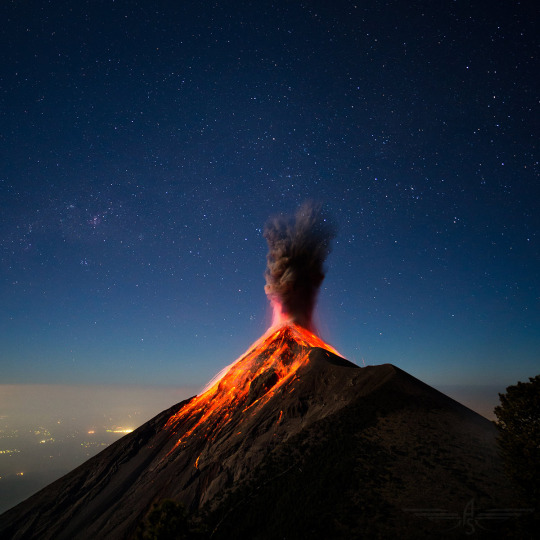

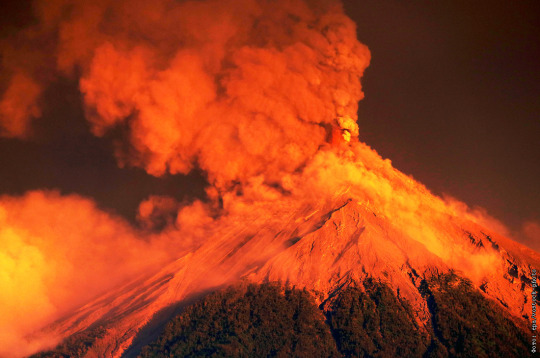
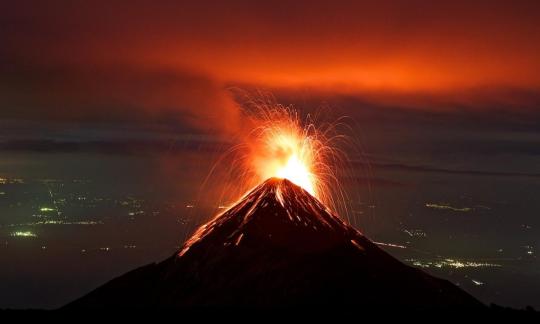




Стратовулкан Фуэго ("вулкан огня") - один из самых активных в Гватемале. Он находится неподалеку от города Антигуа на высоте 3763 м над уровнем моря. Вулкан является частью Тихоокеанского огненного кольца, района, известного своей интенсивной тектонической активностью и многочисленными действующими вулканами. Его постоянная деятельность и близость к населенным пунктам сделали его предметом большого интереса для ученых, геологов и органов по чрезвычайным ситуациям.
Вулкан Фуэго имеет долгую историю, которая насчитывает тысячи лет. Его извержения были задокументированы со времен испанской колонии, и он остается одним из самых активных и опасных вулканов в Центральной Америке. Как и другие стратовулканы, он состоит из чередующихся слоев вулканического материала, включая потоки лавы, пепла и пирокластических обломков.
Фуэго извергается в среднем каждые четыре-пять лет, при этом выбросы газа и пепла достигают 10-километровой высоты. В 2018 году в результате извержения реки лавы хлынули по его склонам, опустошив деревню Сан-Мигель-Лос-Лотес, убив 215 человек, еще столько же пропали без вести. Вулкан также извергался и в 2021 году. После извержения были предприняты усилия, чтобы помочь в восстановлении поврежденной инфраструктуры и оказать поддержку тем, кто потерял свои дома и близких. Кроме того, извержение привлекло внимание к оценке вулканического риска и важности просвещения общественности о вулканической опасности для повышения устойчивости населения перед лицом будущих извержений.
The Fuego stratovolcano ("volcano of fire") is one of the most active in Guatemala. It is located near the city of Antigua at an altitude of 3,763 m above sea level. The volcano is part of the Pacific Ring of Fire, an area known for its intense tectonic activity and numerous active volcanoes. Its constant activity and proximity to populated areas have made it a subject of great interest to scientists, geologists, and emergency management authorities.
Fuego Volcano has a long history that dates back thousands of years. Its eruptions have been documented since the Spanish colonial era, and it remains one of the most active and dangerous volcanoes in Central America. Like other stratovolcanoes, it is composed of alternating layers of volcanic material, including lava flows, ash, and pyroclastic debris.
Fuego erupts on average every four to five years, with plumes of gas and ash reaching heights of 10 kilometers. In 2018, an eruption sent rivers of lava flowing down its slopes, devastating the village of San Miguel Los Lotes, killing 215 people and leaving another 215 missing. The volcano also erupted in 2021. Following the eruption, efforts were made to help rebuild damaged infrastructure and provide support to those who lost their homes and loved ones. In addition, the eruption brought attention to volcanic risk assessment and the importance of public education about volcanic hazards to build community resilience in the face of future eruptions.
Источник:/korzik.net/video/167201-v-gvatemale-vo-vremja-izverzhenija-vulkana-fujego-nachalsja-shtorm-s-molnijami-kotorye-bili-prjamo-v-zherlo.html, //ru.geologyscience.com/стихийные-бедствия/извержение -вулкана/вулкан-де-фуэго/,/sputnik-georgia.ru/20180609/strashnoe-izverjenie-vulkana-v-gvatemale-kadri-s-mesta-bedstvija-240787586.html,/fishki.net/2439490-fotografii-izverzhenija-vulkana-fujego.html, /aif.ru/society/gallery /izverzhenie _vulkana_fuego_v_gvatemale,/vsegda-pomnim.com/vulkany/6011-vulkan-fujego-71-foto.html.
#Guatemala#Antigua#nature#volcano#Stratovolcano Fuego#eruption#lava#ash#lightning#clouds#night sky#landscape photography#nature video#видео#Гватемала#Антигуа#природа#пейзаж#вулкан#Стратовулкан Фуэго#извержение#лава#пепел#молнии#тучи#ночное небо
296 notes
·
View notes
Text
Volcano De Fuego, Guatemala: Volcán de Fuego or Chi Q'aq' is an active stratovolcano in Guatemala, on the borders of Chimaltenango, Escuintla and Sacatepéquez departments. Part of the mountain range of the Sierra Madre, the volcano sits about 16 kilometres west of Antigua, one of Guatemala's most famous cities and a tourist destination. Wikipedia
#Volcano De Fuego#Stratovolcano#Sierra Madre#Guatemala Department#guetmala#Central America#north america#north america continent
154 notes
·
View notes
Text
A volcano less than 30 miles outside of Guatemala City is once again erupting, sending ash, gas and rocks down the mountainside, the country’s National Disaster Reduction Commission reports.
According to data from Global Volcanism Program, the latest eruption cycle of the Fuego Volcano began in 2002, but the recent event is the most significant in several years.
The stratovolcano is less than 30 miles from the country’s capital city and has been sending thick, billowing ash clouds thousands of miles in the sky.
On the volcanic mountain, authorities say they have been closely monitoring pyroclastic flows, which contain gases, ashes and other volcanic material.
Due to the threat of impact from these downslope flows, several small villages have been evacuated for what the government said were “preventative” actions.
According to Guatemala’s National Institute for Seismology, Vulcanology, Meteorology and Hydrology, many of the communities nearest to the summit are poor without substantial transportation.

Officials from The National Coordination for Disaster Reduction are seen conducting evacuation orders for villages surrounding the mountainside. CONRED
10 notes
·
View notes
Text
Exploring the Breathtaking Terrain of Guatemala
Introduction
Guatemala, often referred to as the "Land of Eternal Spring," is a country of extraordinary geographic diversity. Nestled in Central America, it offers a breathtaking terrain that includes towering volcanoes, dense rainforests, serene lakes, and captivating coastlines. In this article, we'll embark on a virtual journey to explore the remarkable landscapes that make Guatemala a paradise for nature lovers and adventure seekers.
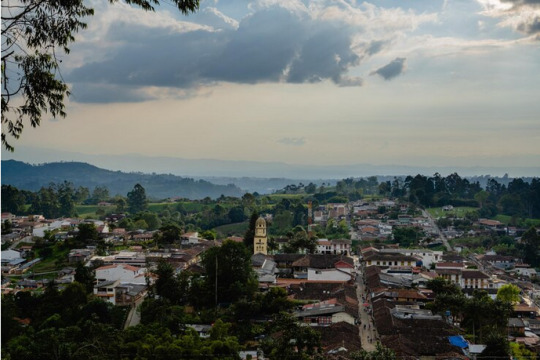
Volcanoes: The Rugged Spine of Guatemala
Volcanic Wonders
One of the most striking features of Guatemala's terrain is its volcanic landscape. The country is home to over 30 volcanoes, some of which are active and others dormant. These majestic giants punctuate the horizon, creating a dramatic backdrop for the lush highlands and lowlands.
Acatenango: This twin-peaked stratovolcano near Antigua is a favorite for trekkers. The challenging ascent offers not only the thrill of conquering its summit but also breathtaking views of its active neighbor, Fuego, which frequently spews lava and ash.
Pacaya: Known for its accessibility, Pacaya is a popular volcano for hiking. The climb leads you through otherworldly landscapes, and at the summit, you can roast marshmallows over the hot vents.
Tajumulco: As the highest peak in Central America, Tajumulco offers a strenuous hike with rewarding panoramic vistas. On a clear day, you can even see the Pacific and Atlantic Oceans from its summit.
Rainforests: The Lungs of Guatemala
Verdant Wilderness
Guatemala's rainforests are an integral part of the country's terrain. These lush, biodiverse ecosystems teem with wildlife, and exploring them is an adventure like no other.
Peten: Located in the northern lowlands, the Peten region is a vast expanse of rainforests. It's home to Tikal, one of the most iconic Mayan archaeological sites, nestled amidst the dense jungle.
Izabal: The Izabal region on the Caribbean coast is another rainforest haven. It's known for its pristine river, Rio Dulce, which meanders through the rainforest and offers a breathtaking natural spectacle.
El Mirador: Deep in the Peten rainforest, El Mirador is one of the most challenging treks in Guatemala. The reward is visiting a Mayan city older than Tikal, surrounded by dense jungle and wildlife.
Lakes: Guatemala's Aquatic Jewels
Glistening Oases
Guatemala's terrain boasts several picturesque lakes, each with its unique charm and recreational opportunities.
Lake Atitlán: Often referred to as the most beautiful lake in the world, Lake Atitlán is surrounded by towering volcanoes and vibrant indigenous villages. The crystal-clear waters are perfect for swimming, kayaking, and even scuba diving.
Lake Peten Itza: This lake near Tikal is an oasis in the midst of the rainforest. It's a serene spot for birdwatching and fishing, and you can explore the remote Mayan site of Yaxha nearby.
Lake Izabal: The largest lake in Guatemala, Lake Izabal offers boat trips to explore its many islands and riverside attractions, including the impressive Rio Dulce canyon.
Coastlines: Tropical Beauty from Coast to Coast
Beach Escapes
Guatemala's terrain also includes some captivating coastlines, both on the Pacific and the Caribbean sides.
Monterrico: On the Pacific coast, Monterrico is famous for its black volcanic sand beaches and turtle conservation efforts. It's a serene spot for sunbathing and birdwatching.
Livingston: On the Caribbean coast, Livingston stands as a unique fusion of Garifuna culture and Caribbean beauty. The beaches here are flanked by palm trees, creating a picture-perfect tropical setting.
El Paredon: For surfing enthusiasts, El Paredon is a tiny coastal village on the Pacific coast with consistent waves and a laid-back atmosphere.
Caves and Cenotes: Subterranean Wonders
Hidden Treasures
Guatemala's terrain isn't limited to what's visible on the surface; it extends below, into a labyrinth of caves and cenotes.
K'anba Caves: The K'anba Caves in Alta Verapaz offer a remarkable adventure. These caves, believed to be sacred by the Mayans, are adorned with ancient art and are accessible by guided tours.
Semuc Champey: Known for its breathtaking turquoise pools, Semuc Champey hides a stunning series of limestone caves, accessible by cave tours.
Grutas de Lanquin: These caves near Semuc Champey are not only naturally awe-inspiring but also historically significant, as they were once used for Mayan rituals.
Conclusion
The terrain of Guatemala area is a treasure trove of natural wonders, from the towering volcanoes that adorn the highlands to the lush rainforests that host diverse wildlife. The serene lakes, captivating coastlines, and the hidden subterranean caves and cenotes all contribute to the rich tapestry of this Central American gem. Whether you're an adventure seeker, a nature lover, or simply someone in search of serene beauty, Guatemala's terrain offers a diverse range of experiences to explore and cherish. Guatemala is not just a country to visit; it's a terrain to be discovered, experienced, and admired for its exceptional natural beauty.
0 notes
Link
1 note
·
View note
Photo

From National Geographic Photo of the Day; March 21, 2018:
Fire Volcano Angel Borrayo, National Geographic Your Shot
Guatemala's Volcán de Fuego, or Fire Volcano, has been continually active for hundreds of years. The volcano stands more than 12,000 feet above sea level, just a few miles from the city of Antigua.
This photo was submitted to Your Shot, our storytelling community where photographers can take part in photo assignments, get expert feedback, be published, and more. Join now to submit your photos.
#national geographic#nature#landscape#geology#volcano#stratovolcano#eruption#Volcan de Fuego#Volcan Fuego#Antigua#Guatemala
6 notes
·
View notes
Video
youtube
Welcome to the news channel of the Angry Nature, Today we will tell you about Popocatepetl volcano,Mexico, Fuego volcano Chile 👇 https://youtu.be/6I1BYSvZFTU Explosive activity continues. Volcanic Ash Advisory Center (VAAC) Washington warned about a volcanic ash plume that rose up to estimated 22000 ft (6700 m) altitude or flight level 220. Volcán Popocatépetl, whose name is the Aztec word for smoking mountain, towers to 5426 m 70 km SE of Mexico City to form North America's 2nd-highest volcano. The glacier-clad stratovolcano contains a steep-walled, 250-450 m deep crater. The Popocatépetl volcano has continued to present intense activity for several weeks, and on the early morning of this Tuesday, January 31, 2023, it registered an impressive explosion in which incandescent material was thrown onto the slopes of the colossus. Likewise, in the last hours Popocatépetl has registered 117 exhalations accompanied by water vapor, other volcanic gases and ash. It has also presented 344 minutes of tremor and three minor explosions on Sunday at 10:54 a.m. and on Monday, January 30 at 1:41 a.m. and 6:21 a.m. It should be remembered that the Volcanic Alert Traffic Light remains in Yellow Phase 2 and the population is recommended to respect the safety radius of 12 kilometers. Records of activity date back to the 14th century and the current eruption period has been ongoing since January 2005, which has included numerous episodes of lava-dome growth and destruction within the summit caldera. #popocatepetl_volcano #mexico_volcano #angry_nature #popocatepetl #explosion #volcánde_popocatépetl #geology _______________________________ The channel lists such natural disasters as: 1) Geological emergencies: #earthquake #volcanic_eruption mudflow, #landslide landfall, avalanche; 2) Hydrological emergencies: #flash_flood #tsunami Limnological catastrophe, floods, flooding; 3) Fires: Forest fire, Peat fire, Glass Fire, Wildfire; 4) Meteorological emergencies: #tornado, ATTENTION: All videos are taken from open sources. The selection is based on publication date, title, description, and venue. Sometimes, due to unfair posting of news on social networks, the video may contain frames that do not correspond to the date and place. It is not always possible to check all videos. We apologize for any errors! Thank you for watching, don't forget to subscribe our channel, We Wish you good Weather,
0 notes
Photo
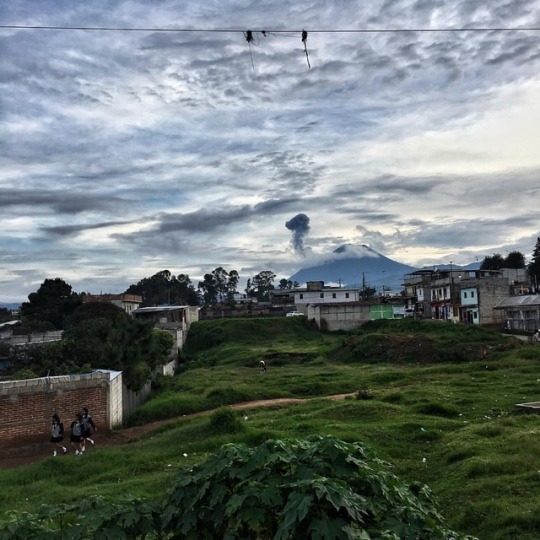
#Gustemalan landscape with the view of the #VolcándeFuego y Agua (known as #Hunahpú by the #Mayan people's) are #stratovolcano located in on the borders of the states of #Chimaltenango, #Escuintla and #Sacatepéquez in #Guatemala. The Volcán de Fuego (#VolcanoofFire) is active and one can see in the background a cloud of smoke being released by the #volcano. / Paisaje #Guatemalteco con vista del Volcán de #Fuego y #Agua (conocido como Hunahpú por el pueblo #maya) son #estratovolcanes ubicados en las fronteras de los departamentos de Chimaltenango, Escuintla y Sacatepéquez en Guatemala. El Volcán de Fuego está activo y se puede ver en el fondo una nube de humo saliendo del volcán. #EverydayGuatemala #iphoneography #Nature #MayaCulture #VolcandeAgua #MotherNature #Guatemala #EverydayLatinAmerica #photojournalism #Maya #JuanCarlos #2017copyright
#sacatepéquez#escuintla#estratovolcanes#everydaylatinamerica#maya#agua#volcano#mothernature#mayaculture#photojournalism#juancarlos#2017copyright#mayan#volcandeagua#chimaltenango#fuego#iphoneography#volcándefuego#gustemalan#nature#volcanooffire#stratovolcano#guatemala#hunahpú#everydayguatemala#guatemalteco
9 notes
·
View notes
Text
Enjoy the Beauty of Acatenango Hiking Trip
Most of the time we become depressed due to the pressure of our daily responsibilities. But, this depression may put a negative impact on our personal life as well as professional life. Have you just found out some similarities in this situation with your life! Then find out a way that may refresh your mind and provide you some positive energy. Here is a suggestion for you. Travelling is such a thing that can offer you great pleasure and are capable to revitalize your mood. And if the trip is a hiking trip, you will be able to hear your breath. But where to go! Here is also the solution to this question. Acatenango hike is the name of the solution.

Why Acatenango Hiking is an Exceptional Option for Travel?
Acatenango is a stratovolcano and hiking Acatenango is the way to feel the greatness of nature. If you have a fascination with thrilling, it is the best trip option for you. Acatenango hiking is a popular activity in Guatemala. Fuego volcano is the real attraction of this trip. It is an active volcano with low-level eruptions occurring hourly. And this eruption offers the best view for the people who are fascinated with an adventurous trip.
youtube
The Specialty of This Hiking Trip
Acatenango Hike is the best way to experience awe-inspiring nighttime views of liquid lava. On this trip, you will be able to experience a different beauty of the sunrise. Audible moans and groans and the smokey essence are the most precious attraction of this hiking trip.
0 notes
Photo

The Fuego volcano is known as a stratovolcano located between the departments of Sacatepéquez, Escuintla and Chimaltenango, in central-southern Guatemala. (at Mirador Volcán De Fuego) https://www.instagram.com/p/B6rlXPfgzck/?igshid=1ej27fkb6z6oj
0 notes
Text
Acatenango Hike
Acatenango is a stratovolcano in Guatemala with a max elevation of 3,976m Located near the city of Antigua.

This Hike is one of the most amazing experiences of my life! An overnight hike with a stunning view of the very aptly named Volcán de Fuego which is an active volcano that is constantly erupting.
This stunning hike starts of in the countryside and as you climb…
View On WordPress
0 notes
Text
Guatemala's Fuego volcano erupts
Volcán de Fuego is an active stratovolcano in Guatemala, on the borders of Chimaltenango, Escuintla and Sacatepéquez departments. It sits about 16 kilometres (9.9 mi) west of Antigua, one of Guatemala's most famous cities and a tourist destination. It has erupted frequently since the Spanish conquest, most recently in June 2018. Fuego is famous for being almost constantly active at a low level. Small gas and ash eruptions occur every 15 to 20 minutes, but larger eruptions are rare. Andesite and basalt lava types dominate, and recent eruptions have tended to be more mafic than older ones. The volcano is joined with Acatenango and collectively the complex is known as La Horqueta.
Beginning in 2002, the Volcán de Fuego entered a new active period, with more or less continuous activity, interspersed with monthly eruptive episodes. These episodes would typically send ash falling on communities within 20km of the volcano, and lava flows about 1-2km from the summit, and the occasional pyroclastic density current. On 3 June 2018, the volcano suddenly produced its most powerful eruption since 1974. Large pyroclastic density currents were produced that over-topped the barranca boundaries they had previously been confined to and unexpectedly hit El Rodeo, Las Lajas, San Miguel Los Lotes, and La Reunión villages in Escuintla, which buried the towns and killed many of the surprised residents. Later, 18 bodies were found in the village of San Miguel Los Lotes. Members of the Shriners International fraternity met six of over fifty burned children, ages 1-16 , that were sent from Guatemala to the Shriners Hospital in Galveston, Texas and accompanied by 5 guardians for receiving the appropriate and medical treatment.
0 notes
Text
Guatemala volcano kills at least 6, covers villages in ash
close

Video
Guatemala volcano blankets nearby villages with ash
A volcano southwest of Guatemala's capital has erupted for the second time this year, setting off loud explosions and spewing ash nearly four miles into the sky.
At least six people have been killed in Guatemala as a volcano near the country's capital city has erupted for the second time this year.
The Volcan del Fuego, roughly 27 miles from Guatemala City, shot ash nearly four miles into the sky. The ash landed all over the villages of San Pedro Yepocapa and Sangre de Cristo.
The stratovolcano - a volcano built from layers of ash and lava - “has erupted on and off for centuries,” according to the U.S. Geological Survey.
Volcan del Fuego, one of the most active volcanoes in Central America, last erupted on Jan. 31.
The Associated Press contributed to this report.
Nicole Darrah covers breaking and trending news for FoxNews.com. Follow her on Twitter @nicoledarrah.
Trending in World

Guatemala volcano kills at least 6, covers villages in ash
Read more: http://www.foxnews.com/world/2018/06/03/guatemala-volcano-kills-at-least-6-covers-villages-in-ash.html
0 notes
Photo

From National Geographic Photo of the Day; October 9, 2018:
Tower of Smoke Daiva Baleviciute, National Geographic Your Shot
Guatemala's Volcán de Fuego, or Volcano of Fire, is one of the most active volcanos in the world. Two months after this photo was taken, in June 2018, the volcano erupted, killing and injuring hundreds of people.
This photo was submitted to Your Shot, our storytelling community where photographers can take part in photo assignments, get expert feedback, be published, and more. Join now to submit your photos.
#national geographic#nature#landscape#geology#volcano#eruption#ash cloud#clouds#Volcan de Fuego#Chi'gag#Guatemala
3 notes
·
View notes
Video
youtube
Welcome to the news channel of the Angry Nature, Today we will tell you about Popocatepetl volcano,Mexico, Fuego volcano Chile 👇 https://youtu.be/6I1BYSvZFTU Explosive activity continues Volcanic Ash Advisory Center Washington warned about a volcanic ash plume that rose up to estimated 21000 ft (6400 m) altitude or flight level 210. Popocatépetl is an active stratovolcano located in the states of Puebla, Morelos, and Mexico in central Mexico. It lies in the eastern half of the Trans-Mexican volcanic belt. At 5,426 m it is the second highest peak in Mexico, after Citlaltépetl at 5,636 m. Scientific and technical personnel from Senapred made a flight yesterday, January 27, to observe the morphological conditions of the volcano. Specialized personnel from the Institute of Geophysics of the National Autonomous University of Mexico participated in the surveillance with the support of the National Guard to protect the lives of the population around the volcano. From the overflight, Senapred reported that it was “possible to determine that the dimensions of the inner crater rim are approximately 390 to 410 meters in diameter, which indicates that there are no significant changes with respect to what was observed in February 2022” Officials currently have the Yellow Phase 2 Level of Volcano Alert traffic light active. Popocatépetl is located 70 km SE of Mexico City, Mexico, and contains a 400 x 600 m wide crater. Records of activity date back to the 14th century and the current eruption period has been ongoing since January 2005, which has included numerous episodes of lava-dome growth and destruction within the summit caldera. #popocatepetl_volcano #mexico_volcano #angry_nature #popocatepetl #explosion #volcánde_popocatépetl #geology _______________________________ The channel lists such natural disasters as: 1) Geological emergencies: #earthquake #volcanic_eruption mudflow, #landslide landfall, avalanche; 2) Hydrological emergencies: #flash_flood #tsunami Limnological catastrophe, floods, flooding; 3) Fires: Forest fire, Peat fire, Glass Fire, Wildfire; 4) Meteorological emergencies: #tornado, ATTENTION: All videos are taken from open sources. The selection is based on publication date, title, description, and venue. Sometimes, due to unfair posting of news on social networks, the video may contain frames that do not correspond to the date and place. It is not always possible to check all videos. We apologize for any errors! Thank you for watching, don't forget to subscribe our channel, We Wish you good Weather,
0 notes
Text
Acatenango Volcano Hike to Enjoy Volcano Eruption
Volcano hiking is a popular activity among backpackers and adventure travelers. And, that is the reason Guatemala has become a desirable destination for hundreds of travelers who wish to experience a volcano hike. Even though Guatemala is incredibly famous for its adventurous Acatenango volcano hike. But, that is not the goal! Many travelers are attracted to this place in order to watch the volcano eruption live up close.
Fuego is an active stratovolcano that is well-known because of its periodic and explosive eruptions. The low-level eruptions of Fuego volcano occur hourly so the travelers can witness the beauty of volcano eruption if they are considering hiking Acatenango volcano and camping overnight. The campsites on the Acatenango volcano are the best viewing points for the Fuego volcano eruption. You can get a clear view to take the best shots with your camera from the campsites.

Fuego volcano is popular due to its small and regular eruptions that delight the travelers. If you are interested to travel in Guatemala to enjoy exciting Acatenango volcano hike and fascinating view of Fuego volcano eruptions, you have to plan the trip thoroughly. Here are some aspects you must consider while handing over the responsibility of all arrangements to a tour agency.
Hostel facility: After arriving at Antigua in Guatemala, the first thing you have to look for a place to get fresh and take rest before exploring the tourist spots and the hike. So, you must check if the tour agency offers the best hostel facility for a comfortable stay.
Shuttle facility: Transportation is an obvious need when you are traveling. So, you have to be sure the tour agency provides shuttle facilities during your stay so that you can travel freely.
Camping and hiking gear: As your goal is to hike Acatenango volcano and camp at the top, you need to be well-prepared with all necessary gear. Check if the agency can arrange the required items so that your journey can be smoother.
Hostel, shuttle facilities, and camping gear are necessary elements for a hiking trip. To make all arrangements smoothly, you can contact a well-renowned tour agency and book a hostel now.
0 notes